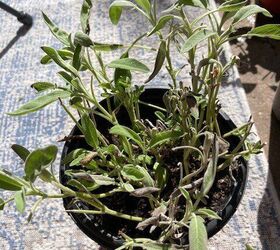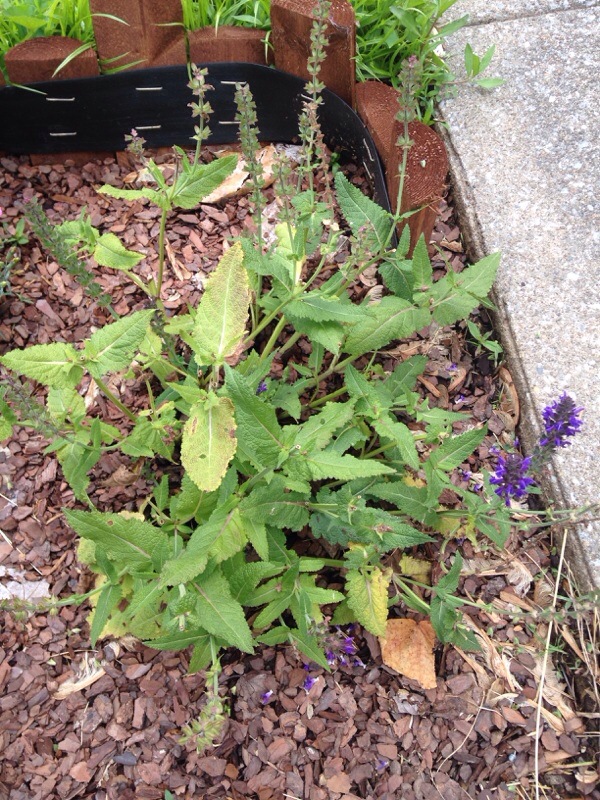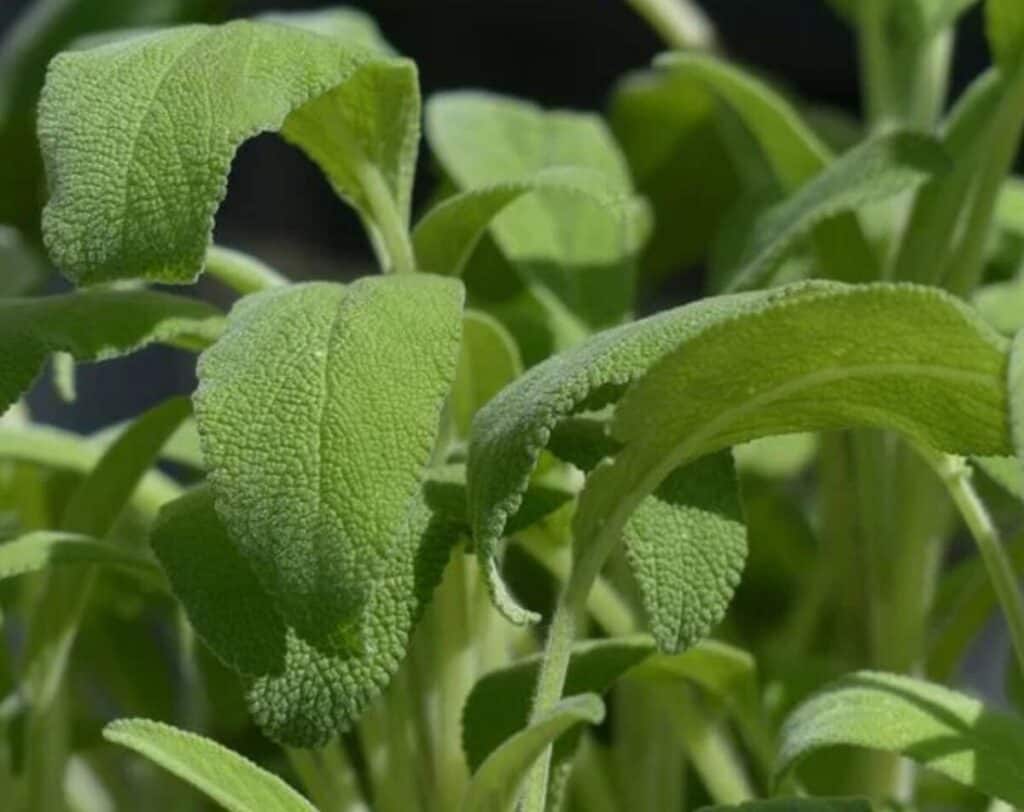Sage plants may wilt or droop for a variety of reasons, including overwatering, fungus, too much fertilizer, or underwatering. The most frequent reason for a sage plant to wilt is overwatering because it is a drought-resistant plant and sensitive to too much moisture near the roots.
It’s crucial to replicate some of the growing conditions of the sage plant’s native environment to ensure that it is healthy and does not wilt or droop as a sign of stress.
Read on to find out the cause of your sage plant’s wilting and how to fix it.
Table of Contents
Too Much Moisture Around the Roots
Sage is a plant native to Southern Europe that thrives on hillsides in a Mediterranean environment. Because of this, sage is evolved to growing in conditions that are almost like a drought, with little rainfall and sandy soils that drain well.
Sage prefers darker soils and is water sensitive, not liking the soil to stay consistently damp around the roots for an extended period of time.
Sage plants’ wilting or drooping leaves are frequently an indication that the soil is excessively wet, which many people mistake for an indication that they need more water.
A few causes of excessive moisture around the roots include:
- watering too much (potted sage only requires watering once per week in hot weather and once every two weeks in cooler conditions).
- soils that drain slowly (sage prefers well draining soil and does not grow well in heavy clay or low lying boggy soil).
- large rains (sage is adapted to climates with low rainfall, however they can easily adjust to growing in rainy climates with good soil preparation).
Excess watering
You are overwatering your sage plant if you water it more frequently than once per week. If it is planted in a pot, reduce the watering to once every week in the summer’s dry, hot weather.
In most circumstances, watering sage grown in garden borders once every two weeks is the ideal watering schedule, especially if there have been a few cloudy days or rainy ones.
Sage should always receive a lot of water each time it is watered in order to grow deep roots, as superficial roots are encouraged by light watering.
Sluggish drained soils
Keep in mind that sage plants are indigenous to nations along the Mediterranean coast, where they thrive in stony or sandy soils and are frequently found on slopes.
Sage grows so well in pots and containers because it is suitable for soils that allow for good drainage and do not hold an excessive amount of moisture.
Sage will droop as a symptom of stress if it is planted in clay soil or rich compost that retains moisture for an extended period of time.
Before planting sage, the soil should always be amended with some horticultural sand or grit to make it more porous so that water can drain through more effectively rather than pool around the roots.
Sage can be planted in a pot or along a garden border. To 80% compost or potting soil, add about 20% sand or grit. This will enhance drainage and mimic the sage’s original Mediterranean environment’s soil characteristics.
I advise moving the sage plant to a pot or container if it has previously been planted in soil that drains slowly.
Changing the soil profile in a container to the sage’s ideal circumstances is much simpler than changing the soil in a garden.
Heavy rainfall
Sage may be grown with some modifications in cooler, wetter climes (like the pacific north west or the UK), even though it is native to hot, arid regions.
The most crucial step in high-rainfall areas is by far proper soil preparation beforehand.
Sage doesn’t have specific soil requirements, but it is crucial that the land has good drainage to counteract the heavy rainfall.
This entails increasing the amount of sand or grit in the soil mixture. In humid conditions, it is always preferable to use more sand than not enough while preparing the soil for sage. To make sure that the soil has the good draining features that sage requires in order to remain healthy, add as much as 1 third sand or grit to 2 thirds multipurpose compost or potting soil.
Additionally, I would advise planting sage plants far apart in rainy climates. This will guarantee that the sage is in full sunlight as well as that the soil around it is not overly shadowed, which could slow down evaporation and result in moist soils.
The sage plant can recover from its wilting or drooping appearance due to water stress within a few weeks if you make sure you’re watering it properly, prepare the soil to increase drainage, and place the plant in full sun so the dirt around the roots dries out better.
Fungal Disease Causes Wilt
Lavender, rosemary, and sage are just a few of the woody perennials that are afflicted by the fungus infection Verticillium wilt. Verticillium wilt symptoms for sage plants include wilting, foliage dropping off, and yellowing leaves.
The sage plant is frequently killed by this illness, and as the pathogens can persist in the soil for a long period, any other plants planted nearby may also contract the disease.
The best course of action if you’re determined to keep the sage alive is to take a cutting from a healthy, disease-free area of the plant and reproduce it (watch this video for how to propagate sage).
If this is not possible, dispose of the sick plant properly by burning it, and apply a fungicide to the soil.
In order to protect sage plants against fungal infection, it is best to have good soil drainage and to water in a way that allows the soil to dry out a little between applications.
Too Much Fertilizer can Cause Wilt
The application of excessive fertilizer is another factor in the appearance of wilting or drooping sage plants.
On its natural habitat, sage grows well in sandy or stony soil, frequently on hillside slopes. Sand does not replenish the soil with many nutrients, nor does it hold onto them as well as loam soil does.
The sage plant may appear to be withering if the soil conditions are unnaturally too rich in nutrients due to a fertilizer since too much nitrogen can lead to:
- an overabundance of foliage growth that has a withering or drooping appearance and is fragile, sappy, and more susceptible to disease.
- a softer flavor and perfume from the leaves.
- The beginning of yellowing leaves is another indication of elevated nitrogen levels.
In most circumstances, fertilizer is not required to grow sage in garden soil, but if the plant is in a container or has showed signs of slow development, a spring application of a half-strength all-purpose general plant fertilizer may be helpful to encourage additional growth.
If you have applied too much fertilizer, stop and let the plant recuperate. The growth should resume normally the following season instead of taking on a wilted appearance.
Under watering
This may be the situation if…
- The sage plant is in an inadequately sized pot.
- The sage has been neglected and is indoors.
Small pots tend to dry up too quickly in full sun and heat up too much for the roots of the sage to absorb properly.
Sage may need to be watered more frequently than once a week in small pots; the remedy, though, is to replant the sage in a larger pot that can hold more soil and won’t heat up as much in direct sunlight.
Sage plants from the garden center can start out fairly small, so I advise repotting it in the spring of each year or so as it grows, or you can plant it in a pot that is around 12 to 16 inches in diameter proportionally. A pot of this size enables the sage’s roots to develop properly so that it can reach the water and nutrients it needs and serves as insulation for the roots in the winter.
To avoid the sage from wilting or drooping, make sure the pot’s base has drainage holes that will let excess water drain away and allow the soil to dry.
Sage growing indoors may be wilting as a result of inadequate watering (around once every two weeks is the right balance).
A sage that appears to be wilting because it was not given enough water is actually quite hardy and will bounce back with a good bath and more regular watering.
Key Takeaways:
- Sage plants prefer the soil to dry out between waterings because they are drought-tolerant plants. Sage plants typically wilt as a result of stress brought on by excessive wetness around the roots. Sage can wilt due to fungus, inadequate watering, and excessive fertilizer use.
- Make sure the soil drains well, and water the sage as needed (water once every 2 weeks or once a week in hot weather).
- Sage is not a heavy eater and prefers medium levels of soil nutrients; therefore, do not apply a high nitrogen fertilizer. The plant may wilt and its leaves may turn yellow from an excess of nitrogen.
- If the pot is too tiny and unable to hold enough soil or moisture, underwatering may cause the sage to wilt. After a drought, sage reacts well to watering.
FAQ
What causes a leaf to curl?
Many issues, such as insect damage, disease, abiotic conditions, or even herbicides, can result in curled leaves. When they suck plant juices from fresh or young leaves that are still growing, a variety of insect pests cause the leaves to curl. These include aphids, thrips, and whiteflies. Whiteflies have two different ways in which they might harm a plant. The first is regarded as “direct” harm. Whiteflies can cause major damage to plants by sucking their juices, which makes their leaves turn yellow, shrivel, and die off too soon. How can you tell if sage is overwatered?
If your sage is overwatered, it will become drooping and its leaves will begin to turn yellow. Root rot, which occurs when the roots start to decompose and die, may potentially affect the plant. Your sage plant may have white powder on its leaves, which is an indication of mildew.
Why is my sage bush dying?
Sage plants may wilt or droop for a variety of reasons, including overwatering, fungus, too much fertilizer, or underwatering. The most frequent reason for a sage plant to wilt is overwatering because it is a drought-resistant plant and sensitive to too much moisture near the roots.



